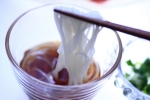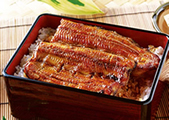You may not have witnessed the subtle change at one of your visits to the conbini or the local supermarket yet, but Japan’s culinary summer has already begun. With food always being an indicator of seasons in Japan, it shouldn’t come as a surprise that there is a wide variety of summer dishes (not even necessarily cold) worth trying. Especially in times when the use of air conditioners is being kept at a minimum, dishes that are both cool and light offer a welcome relief.
To start with, a personal favorite: Hiyashi Chuka (冷やし中華). A main staple at any convenience store or supermarket in the summer months, this dish combines cold noodles with vegetables, ham and eggs, and tops it all off with a vinegar/sesame soy sauce.
 Next is another noodle dish. Sōmen (素麺) are wheat flour noodles that are served cold and dipped into a light soy flavored sauce and garnished with spring onions and ginger. Served with ice cubes, it even manages to cool you down visually. The fact that this dish is extremely easy to make at home and surprisingly refreshing, should be all the more reason to try it this summer. Also note that spicy side dishes and condiments such as ginger in all its forms not only make your food more interesting by adding a little kick, but are known to naturally cool you down.
Next is another noodle dish. Sōmen (素麺) are wheat flour noodles that are served cold and dipped into a light soy flavored sauce and garnished with spring onions and ginger. Served with ice cubes, it even manages to cool you down visually. The fact that this dish is extremely easy to make at home and surprisingly refreshing, should be all the more reason to try it this summer. Also note that spicy side dishes and condiments such as ginger in all its forms not only make your food more interesting by adding a little kick, but are known to naturally cool you down.
 Not as cold, but equally delicious and traditional is unagi (鰻), charcoal roasted eel. For the real experience a pricey dinner at a good Japanese restaurant may be advisable, however, a sunny day, a picnic at the park, and a unagi lunch box can end up being just as good.
Not as cold, but equally delicious and traditional is unagi (鰻), charcoal roasted eel. For the real experience a pricey dinner at a good Japanese restaurant may be advisable, however, a sunny day, a picnic at the park, and a unagi lunch box can end up being just as good.
 Finally, some slightly sweeter recommendations for those really hot days. First off we have kakigori (かき氷). This is basically shaved ice in a cup, for which you can choose syrup from a number of flavors such as green tea, cherry, strawberry etc. Traditionally, kakigori was made by using a hand driven machine to spin a block of ice over an ice shaving blade. While these have become rare, with electric versions having being the norm, you can still see them on summer streets occasionally, and even purchase them for home use.
Finally, some slightly sweeter recommendations for those really hot days. First off we have kakigori (かき氷). This is basically shaved ice in a cup, for which you can choose syrup from a number of flavors such as green tea, cherry, strawberry etc. Traditionally, kakigori was made by using a hand driven machine to spin a block of ice over an ice shaving blade. While these have become rare, with electric versions having being the norm, you can still see them on summer streets occasionally, and even purchase them for home use.
A “healthier” alternative during the summer months is the omnipresent watermelon. This may be a little more expensive in Japan than in your home country, but very few things are as refreshing as a cool slice of suika on a hot August day. For ice cream aficionados, the so-called suika bar, available throughout the summer at convenience stores and supermarkets, is worth a try. While being admittedly artificial, the combination of watermelon ice cream with chocolate is rather enticing.
So there you have it, enjoy Japanese food as the Japanese do, season by season. Be open for new tastes and be surprised by how refreshing noodles and horseradish can be. After all, it doesn’t need to be salad every day of the summer.
